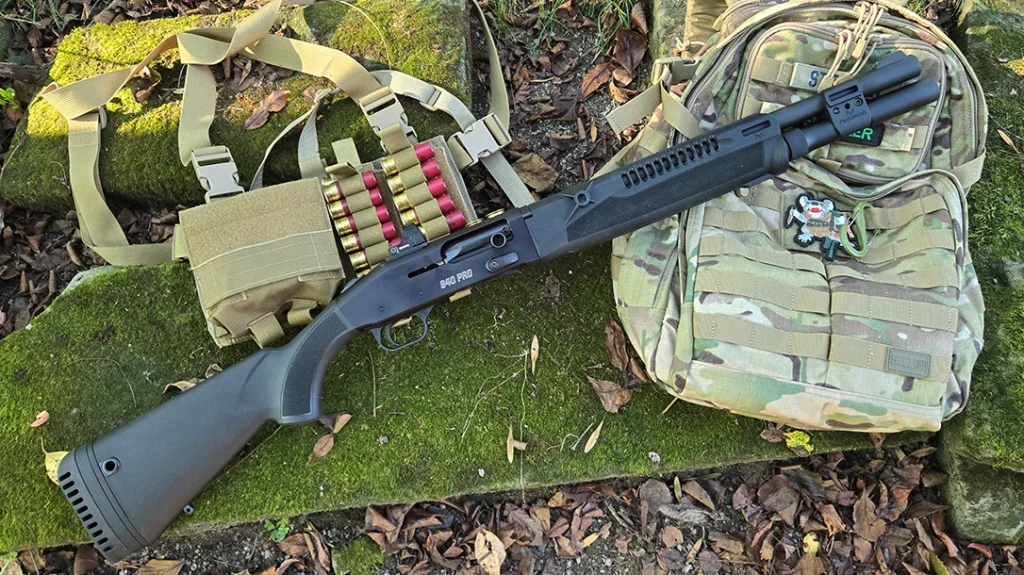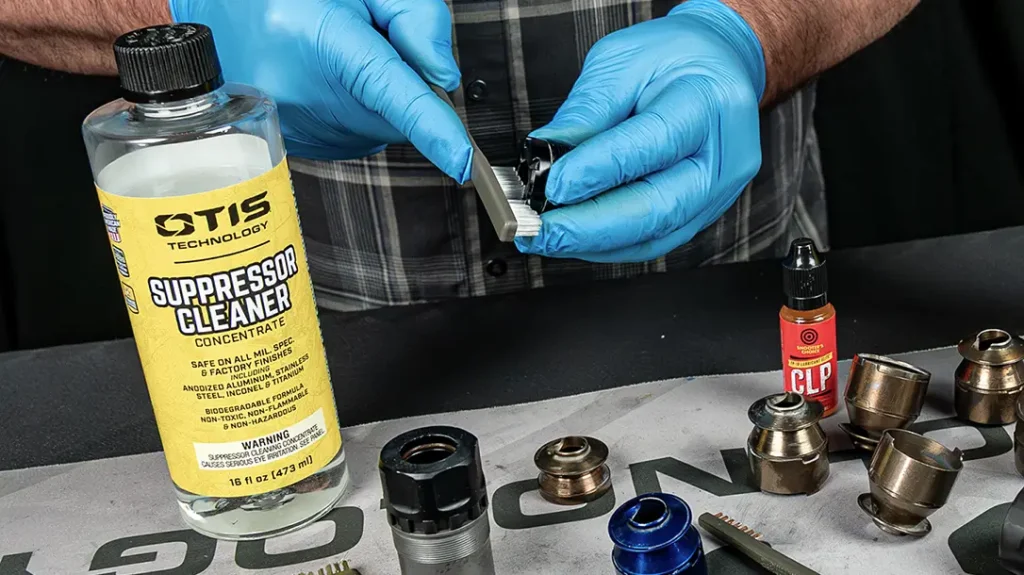It’s a little like shooting a bird with a shotgun, but in reverse and with a rifle. It’s more difficult, too. And there is a very serious, practical aspect to the Aerial Rifle training offered to select individuals and units by Dillon Aero—it can save lives and protect this country.
Shooting from a helicopter at an enemy combatant or a criminal who is a threat is a challenge. This became obvious when, in 2005, a foreign spec-ops unit hired Dillon to provide a crew and helicopter from which to practice aerial riflery. The special forces unit claimed to have the expertise to train and engage in shooting from a helicopter, but it became obvious that their claims were only fantasy. Afterwards, in frustration, John Doyel and Chris Dillon decided to figure out how to do it, and they did. Now Dillon Aero offers that training.
Dillon Aero is a sister company of Dillon Precision, which designs and makes excellent reloading equipment. Dillon Aero also manufactures the M134D minigun and provides training in its maintenance and use to government agencies and military customers. Dillon maintains a fleet of privately owned helicopters, mainly operated to support its research and development work, but these aircraft are also used as training platforms for both the M134 and Aerial Rifle course, which has been in existence for seven years.
Advertisement — Continue Reading Below
Dillon is committed to protecting this country and offers Aerial Rifle training at cost, though it is strictly limited to military and LE personnel. Dillon will also donate time and equipment on occasion. That’s a pretty high level of commitment for a commercial enterprise, because operating a Huey helicopter for several hours is not cheap.
Taking Flight
As developed by Dillon, the purpose of the Aerial Rifle course is to teach slow, deliberate fire from a helicopter at speeds from 20 to 60 knots and ranges out to 150 meters. It is not a precision rifle course, even though many of the law enforcement personnel trained are SWAT snipers who use scoped guns in their work. But for this, scoped guns don’t work well because the field of view and parallax—combined with turbulence and normal vibrations from the helicopter—make it difficult to acquire a target and maintain a good sight picture. Instead, AR-style guns with non-magnifying optics like EOTech or Aimpoint units with red dots work much better.
By using the right weapon system and applying the proper techniques, a typical student can expect to achieve one hit on target for every three rounds fired. And those misses will be very close. Some can get even better and score hits with two out of three rounds. Considering all the variables involved—target size, helicopter speed, target distance, turbulence, vibration, and how rapidly the sight picture changes—one in three is a pretty good ratio.
Advertisement — Continue Reading Below
Class begins with a short stand-up lecture of the course goals, safety and the basic concepts of shooting from a fast-moving aerial platform at a small stationary target. There are mathematically calculated firing solutions for various situations, but unless you are an incredibly gifted mathematician with a brain like a computer or have a photographic memory with instant recall that you can access in a fast-moving, stressful situation, the mathematical solutions are only a rough guide to get the student started.
This is a learn-by-doing class, so after about 15 minutes, the lecture was over and we took the short walk to the range, where we examined the targets and got familiar with the layout of the impact area. Everyone had to know the flight patterns, approaches and departures, as well as exactly what was going to happen and how the course of fire was designed. The range is in a remote part of the Arizona desert, but safety and zones of fire were still important.
The instructors described the training aids to get students on target, and they also explained that after enough repetitions, the brain would begin to work out firing solutions on its own and the aids would not be needed. Learning to shoot from a moving aerial platform is a bit like learning to throw a football at a running teammate. The brain automatically, through a series of attempts and failures, figures out where to throw the ball, or in this case aim the rifle, so the projectile gets to the intended place at the intended time. Eventually the shooter just seems to know where to aim to score hits.
Advertisement — Continue Reading Below
Firing At 60 Knots
Aerial shooting is a team endeavor, so communication between the shooter and the pilot is very important. It is often the pilot who sees the target first, so he needs training in identifying targets and describing them and their position. The shooter needs to be able to tell the pilot where he wants the helicopter and at what speed he wants to travel, both of which are essential elements in calculating a firing solution. Communications need to be clear and quick because things happen fast at 60 knots and only 100 feet above the deck.
Generally, classes consist of four students because this maximizes shooting time. Students are mostly from law enforcement or special military units with a need to be able to engage hostiles from a helicopter—Air Force Pararescue Jumpers are one group, for example. This class consisted of two police snipers, an Army Special Forces member and, the oddball, this gun writer. The class was split into two groups to give each person experience shooting from both sides of the helicopter.
Before taking off, the gun is secured to the shooter with a sturdy sling, in my case a Cobra Quad X sling from Savvy Sniper. Then the student is secured to the helicopter with a tether or harness that can be quickly detached if necessary.
Advertisement — Continue Reading Below
To begin the training, the flight pattern is a straight path parallel to the firing line at 40 to 50 knots, 100 feet above ground level and 100 meters from the target. The pilot flies first in one direction and then the other to give both shooters turns at developing their skills.
Things happen fast. With the doors removed from the Huey, there is plenty of room to shoot, but the targets appear small and the opportunity to shoot is short. Wind whips at the shooter and the rifle, air turbulence can bounce the aircraft without warning, and the helicopter naturally vibrates, making aiming difficult. Both eyes need to be open to provide the shooter with a wide field of view, and that is why a non-magnifying optic is better than a magnifying scope. There is a lot of sensory input to process in a short time while remembering where to aim and when to press the trigger. But if the student keeps his wits and has paid attention to the instructor, a first-round hit is possible.
After the first shooter has made his run, the pilot banks hard and begins a turn to reverse direction for the other shooter. In level flight, the horizon and sky fill the view from the door, but in the turn, all the shooter can see is the ground flashing by 100 feet below. In a few seconds, the shooter on the opposite side has his chance at embarrassment or glory. All the time, instructors offer advice on how to score hits.
Advertisement — Continue Reading Below
The series of passes and turns continue until both students have fired about 60 rounds in three-round strings. After landing in a cloud of dust, the first two students change places with the other two, and the pattern is repeated. After they finish, it’s time for a lunch break.
In the relatively short break time, the mind subconsciously begins processing the information gathered from the first period, so, when shooting resumes, firing solutions come faster and with less thought. Hits on targets increase for most students.
The Next Level
Eventually, more advanced shooting scenarios are introduced. Instead of only firing while the helicopter is moving at a steady speed in a straight line parallel to the firing line, the pilot orbits a fixed target. While one might think it would be easier to hit the target when the aircraft is moving in a circle around it, that is not the case because the helicopter does not orbit in a perfect circle. That makes the aiming lag change constantly.
Recognizing that the shooter may have to engage a target when the helicopter is landing or taking off, the shooter practices firing during approaches and departures. Because helicopter speed constantly changes, a good deal of judgment is required about how much lead to apply. But after only limited practice, it is surprising how many accurate hits the shooter can deliver. The brain is an amazing piece of equipment.
Advertisement — Continue Reading Below
Not all operations are in bright daylight, so Dillon conducts night training with night-vision equipment. Quality Generation 3 night-vision goggles (NVGs) are recommended. Shooting with NVGs is a difficult skill to learn even on the square range under ideal conditions, so I spent some time on solid ground with Aaron Kirch of Dillon at the Scottsdale Gun Club. It takes practice to do it right, and the student’s first experience with NVGs should not be in a helicopter.
Using an infrared (IR) laser makes it easier to shoot because there is no need to align the NVG—an optic itself—behind another optic. Instead, the shooter just puts the laser on target and fires. But multiple shooters can easily confuse their laser with someone else’s. Therefore, it is important to learn how to use an optic with night-vision settings like an EOTech or Aimpoint instead of a laser because it may be necessary to do so.
Snipers’ Report
Students have high praise for the quality of instruction and course content. One of the students was a police SWAT sniper from a large Arizona metropolitan force who had taken the class before. He was very enthusiastic about the course and Dillon Aero and its commitment to supporting law enforcement and the military. The student’s agency has deployed aerial riflemen on incidents in the past and was continuing to use them.
The other police sniper who attended the course was from a large southwestern metropolitan agency that was considering adding aerial riflemen to its asset list, and attending the Dillon course was part of the evaluation phase. Both snipers commented more than once that funding was a constant constraint on the ability of the police to implement an aerial riflemen unit, and Dillon’s support was much appreciated.
Dillon Aero has created a new technique to aid law enforcement and the military in doing their jobs. For qualified units or agencies—you know who you are—get in touch with Dillon Aero. For more information, visit dillonaero.com or call 800-881-4231.









































